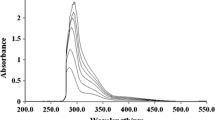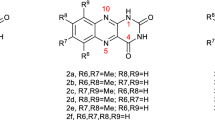Abstract
Triphenyl tetrazolium chloride in vitro reduction by cells produces a red formazan pellet which can be extracted and measured. We have shown that such reduction is associated with animal cell growth, and particularly with the specific growth rate, so the measurement of Triphenyl tetrazolium chloride reduction is proposed as a physiological marker of the exponential growth of cultured cells. Further application of this technique is shown using this Redox reaction for estimating plasmacytoma fusion potential for hybridoma cell line production.
Similar content being viewed by others
Abbreviations
- TTC:
-
2,3,5-Triphenyl Tetrazolium Chloride
References
BajajYPS and ReinertJ (1977) Cryobiology of plant cell cultures and establishment of gene bank. In: ReinertJ and BajajYPS (eds.) Applied and Fundamental Aspects of Plant Cell, Tissue and Organ Culture. (pp 757–777) Springer Verlag, Berlin, Heidelberg and New York.
BurtonK (1956) A study of the conditions and mechanisms of the diphenylamine reaction for the colorimetric estimation of deoxyribonucleic acid. Biochem. J. 62: 315.
Fazekasde StGroth (1960) Monoclonal antibodies and how to make them. Transplantation Proc XII: 447.
HanksJH and WallaceJH (1958) Determination of cell viability. Proc. Soc. Exper. Biol. Med. 98: 188.
HorobinRW (1982) Selection of optimum tetrazolium salt for use in Histochemistry: the value of structure staining correlation. Histochem. J. 114: 301.
KennettRH (1980) Fusion by centrifugation of cells suspended in polyethylenglycol. In: KennettRH, McKearnTJ and BechtolCB (eds.) Monoclonal Antibodies. Hybridomas: A New Dimension, in Biological Analyses. (pp. 365–367) Plenum Press, New York and London.
LowryOH, RosebroughNJ, FairandrAL and RandallJ (1951) Protein measurement with the folin phenol reagent. J. Biol. Chem. 193: 265.
MerchantDJ, KarinRH and MurphyWH (1965) Handbook of cell and organ culture. pp. 157–168 Burgess Pub. Minneapolis.
NachlasMM, MarguliesSI and SeligmanAM (1960) Sites of electron transfer to tetrazolium salts in the succinoxidase system. J. Biol. Chem. 235: 2739.
OteroAJ, RodriguezI and RodriguezBL (1989) Inmunoensayo potenciométrico de enzima ligada (IPELI) para la detección del subtipo ‘ad’ del antigeno de superficie de la Hepatitis B (HBsAg). Interferón y Biotecnologia 6: 3.
OteroAJ, SarracentJ, Fernandez-YeroJL and RodriguezI (1984) A 10 microliter ultramicro ELISA for detection of monoclonal antibodies against alphafetoprotein. Hybridoma 3: 391.
PaulJ (1975) Cell and Tissue Culture. 5th Ed., p. 46, Churchil Livingstone. Edinburgh, London and New York.
PuckTT and MarcusPI (1956) Clonal growth of mammalian cells in vitro Growth characteristics of colonies from single HeLa cells with and without ‘feeder layer’. J. Exp. Med. 103: 273.
SkehanP and FredmanS (1984) Non-exponential growth by mammalian cells in culture. Cell Tissue Kinet 17: 335.
SlaterTE, SawyerB and StreuliV (1963) Studies on a succinate-tetrazolium reductase system III. Points of coupling of four different tetrazolium salts. Biochim. Biophys. Acta 77: 383.
SmithFE (1952) Experimental methods in population dynamics: a critique. Ecology 333: 441.
SteponkusPL (1971) Effect of Freezing on dehydrogenase acyivity and reduction of tryphenyl tetrazolium chloride. Cryobiol 8: 250.
TowillLE and MazurP (1975) Studies on the reduction of 2,3,5 Tryphenyl tetrazolium chloride as a viability assay for plant tissue culture. Can. J. Bot. 53: 1097.
WhealsAE (1977) Transition probability and cell cycle initiation in yeast. Nature 267: 647.
Author information
Authors and Affiliations
Rights and permissions
About this article
Cite this article
Otero, A.J., Rodríguez, I. & Falero, G. 2, 3, 5-triphenyl tetrazolium chloride (TTC) reduction as exponential growth phase marker for mammalian cells in culture and for myeloma hybridization experiments. Cytotechnology 6, 137–142 (1991). https://doi.org/10.1007/BF00373031
Received:
Accepted:
Issue Date:
DOI: https://doi.org/10.1007/BF00373031




